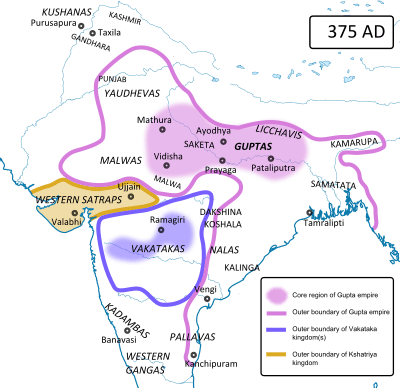Yaudheya

Yaudheya or Yaudheya Gana was an ancient confederation who lived in the area between the Indus river and the Ganges river. They find mention in Pāṇini's Ashtadhyayi and Ganapatha. There are other references to them namely in Mahabharata, Mahamayuri, Brihatsamhita, Puranas, Chandravyakarana and Kashika. As references are spanned from writings of early period to the medieval period, the chronology of Yaudheyas perhaps spans from as early as 500 BCE till 1200 CE. They were in zenith of their power from about 200 BCE to 400 CE.
Puranic reference
Puranas (e.g. Brahmanda, Vayu, Brahma and Harivamsha) described Yaudheyas as the descendants of Usinara and Nrigu.[1]
Literary and epigraphical references
The earliest mention of Yaudheyas is in Ashtadhyayi (V.3.116-17 and IV.1.178) of Pāṇini (c.500 BCE) where Yaudheyas are mentioned amongst Ayudhajivin Sanghas.
Later, the Junagadh rock inscription (c. 150 CE) of Rudradaman I[2] acknowledged the military might of the Yaudheyas "who would not submit because they were proud of their title "heroes among the Kshatriyas"", although the inscription claims that they were ultimately vanquished by Rudradaman.[3][4]
Rudradaman (...) who by force destroyed the Yaudheyas who were loath to submit, rendered proud as they were by having manifested their' title of' heroes among all Kshatriyas.— Junagadh rock inscription[5]
The Allahabad pillar inscription of Samudragupta[6] also mentioned about the Yaudheyas. Varahamihira in his Brihatsamhita (XIV.28 and XVI.22) placed them in the northern division of India.
Numismatic evidences
-

Six-headed Karttikeya on a Yaudheya coin. British Museum.
-

Coin of the Yaudheyas with depiction of Kumāra Karttikeya
-

Karttikeya shrine with antelope. Yaudheya, Punjab, 2nd century CE
Their territory included on the west–Sutlej, Dipalpur, Satgarha, Ajundhan, Kahror, Multan, on the east - Bhatner, Abohar, Sirsa, Hansi, Panipat and Sonipat and on the north - Kangra. These were listed based on the assumptions of coin finds. Even Haryana and Panjab were included in the territory they might have ruled.
The existence of a powerful clan known as Yaudheyas has come to light mainly from their coins and coin-moulds found in large number in this area.[7]
Later developments
Yaudheyas were the rulers of South-Eastern Punjab and Rajasthan.
See also
- Ahibaran, the most prominent Yaudheya king
References
Footnotes
- ↑ Pargiter, F.E. Ancient Indian Historical Tradition Motilal Banarasidass, Delhi, 1972 pp.109
- ↑ Junagadh Rock Inscription of Rudradaman I, accessed on 23 March 2007.
- ↑ Rosenfield, "The dynastic art of the Kushans", p132
- ↑ Rapson, "A catalogue of the Indian coins in the British Museum", p.lx
- ↑ Source
- ↑ Allahabad Posthumous Stone Pillar Inscription of Samudragupta, accessed on 23 Marah, 2007.
- ↑ Allan, John A Catalogue of the Indian Coins in the British Museum (Ancient India), London, 1936, Pl. XXXIX.22
Further reading
- Dasgupta, K.K. A Tribal History of Ancient India: A Numismatic Approach, Calcutta, 1974.
- Lahiri, Bela Indigenous States of Northern India (Circa 200 B.C. - 320 A.D.), University of Calcutta, 1974.
